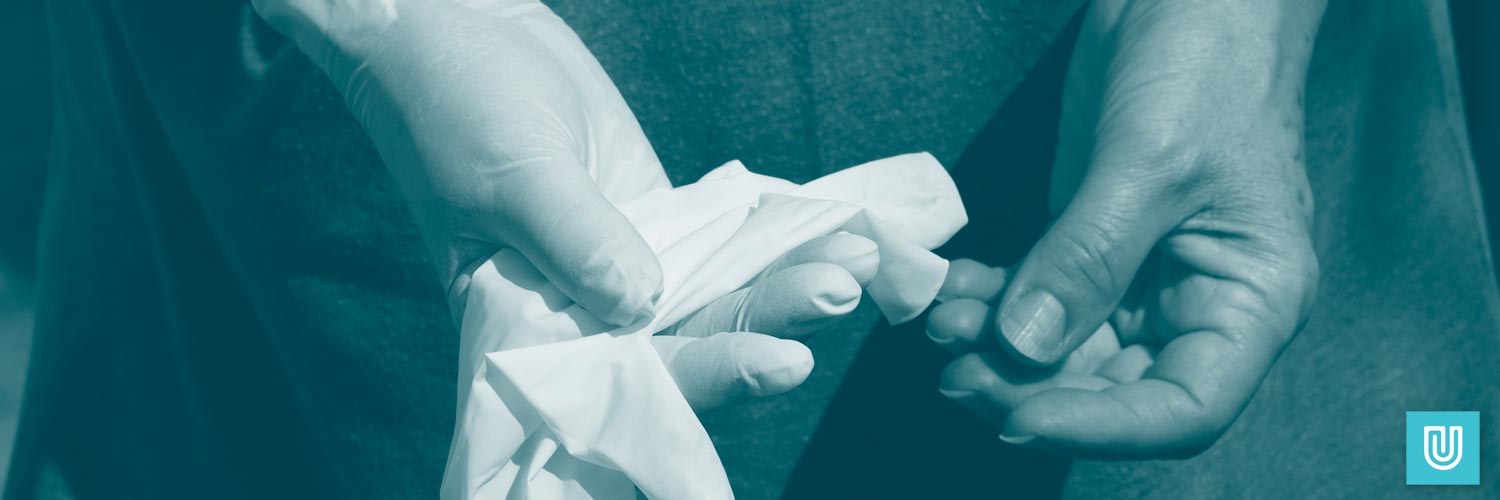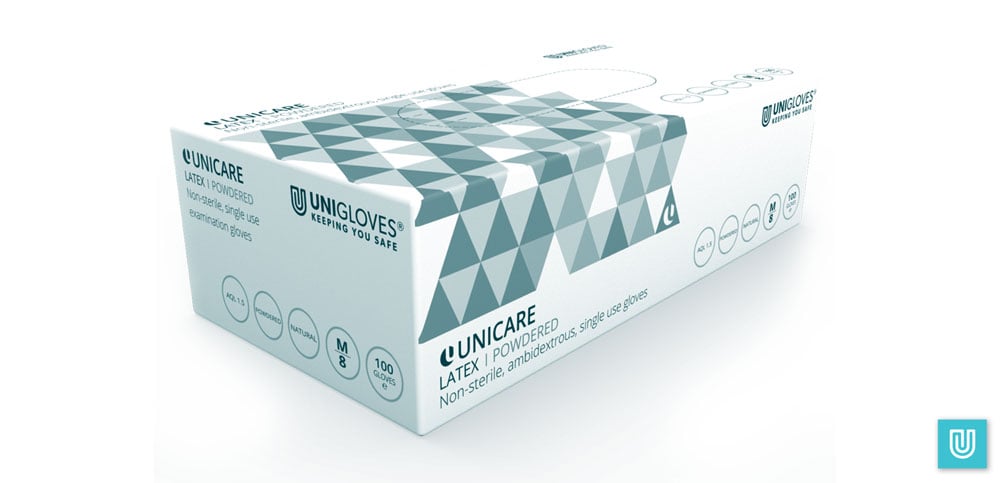Selecting the right glove for your industry and particular application can be a complex process, given all of the options available. The safety of your workers, customers and the general public is paramount, as is ensuring the job is done properly.
When it comes to selecting a glove, one of the most important decisions you’ll make is whether to opt for a powdered or powder-free glove. Powdered latex gloves are a popular choice for several reasons, although they do have some drawbacks. Here, we outline the benefits and alternatives to powdered latex gloves to help you make the right choice for your task.
What are powdered latex gloves?
Latex gloves are made from natural rubber latex (NRL), which is tapped from rubber trees, or Hevea brasiliensis. In powdered latex gloves, the inside of the glove is coated in a fine powder – usually cornstarch – which makes the gloves easier to don and remove, effectively reducing the risk of tearing the glove. The powder can also help to enhance grip and reduce sweating inside the glove, which reduces moisture.
Powder-free gloves, on the other hand, do not have this powder coating inside the glove, and can therefore be more difficult to don and remove. To overcome this issue, manufacturers have come up with new processes which help to reduce this issue in powder-free gloves, including treating gloves with a chlorine solution which reduces powder residue and latex proteins, but leaves the gloves less form-fitting than their powdered alternatives.
Why are latex gloves powdered?
Disposable latex gloves, often called examination gloves, are an extremely thin and flexible glove, making them ideal for intricate tasks that require a high level of touch sensitivity and dexterity. While these gloves are very elastic, they are prone to tearing and ripping when they are put on or removed because of their thin construction. Powder was originally added to disposable gloves to reduce the risk of damaging the glove, as well as to reduce moisture from sweating, which helps to enhance grip.
Powdered latex gloves are extremely comfortable to wear, and the reduction in moisture can help to avoid irritation of the hands while wearing the gloves. Traditionally, powdered latex gloves were preferred in healthcare fields, because easy donning and removal, dexterity, and touch sensitivity are critical in these roles.
In recent years, however, powdered latex gloves have become less common in many industries. The powder used in these gloves, although helpful in reducing moisture and the risk of tearing, can increase the risk of latex allergies from particles in the air.
Furthermore, the powder itself can be a contaminant for materials and surfaces they come into close contact with. For these reasons, many manufacturers now produce powder-free disposable gloves with enhanced durability, using alternative solutions for easier donning and removal. Although these options exist, many workplaces still prefer the comfort and ease-of-use of powdered latex gloves.
Are powder-free latex gloves food safe?
Because the powder particles in powdered latex gloves can escape the glove and contaminate the air and surfaces nearby, they should be chosen carefully in food preparation and processing applications. Only powdered gloves which use USP grade cornstarch and which are tested to EN1186 (therefore deemed food safe) should be used.
Unigloves’ powdered latex gloves contain only USP grade cornstarch and are suitable for contact with all food types, making them ideal for use in food preparation and processing fields.

Do hospitals still use powdered latex gloves?
Latex gloves, whether powdered or powder-free, represent a potential risk to both users and those they come into contact with. This is because the proteins in NRL can cause allergic reactions or sensitivity in some people. Type I (immediate) and Type IV (delayed) sensitisation can lead to irritation and redness, allergic reactions such as itchiness and rashes, or even (in severe cases) anaphylactic shock.
The Health and Safety Executive (HSE) in the United Kingdom recommends conducting a thorough risk assessment before choosing to use latex gloves in the workplace, especially in health and social care environments.
Recent research has found that although latex allergies are a risk factor, low-protein alternatives are unlikely to cause new reactions or allergies. However, the powder becomes an additional risk to those with sensitivity or latex allergies – including glove users and those they are in contact with – as powder particles can act as a carrier for NRL proteins, which may become airborne. Additionally, the powder particles themselves can lead to contact dermatitis, causing irritation, for some people. This kind of irritation is quite rare but is a factor that should be considered when selecting a glove for your workplace.
For these reasons, the HSE recommends using gloves which are low-protein (if not latex-free) and powder-free in applications where Type I or Type IV sensitisation are a risk factor, and has recommended that latex gloves be avoided entirely in hospitals and healthcare roles, if possible.
Are latex powdered gloves bad for eczema?
Atopic dermatitis and contact dermatitis are both common forms of eczema. While atopic dermatitis is a chronic condition caused by an autoimmune disorder, contact dermatitis occurs as a reaction to exposure to certain chemicals or irritants. While neither latex nor the powder in latex gloves cause atopic dermatitis, wearing waterproof gloves can exacerbate the condition and cause flare-ups. This is generally due to irritation caused by the trapped moisture in the glove, and more rarely, by the powder itself.

On the other hand, contact dermatitis can be caused by the very things that your latex gloves are protecting you from. Contact dermatitis can be experienced by anyone, even if they have no previous history of dermatitis. This is why wearing safety gloves is so important when coming into contact with potentially hazardous or irritating materials such as chemicals, alcohols, detergents and more.
The powder in powdered latex gloves can actually help to prevent eczema flare-ups caused by moisture trapped against the skin, as they reduce sweating. However, cotton-lined gloves are often preferred by those who are prone to the condition.
What are powdered latex gloves used for?
Needless to say, there are benefits and drawbacks to the use of powdered latex gloves in any workplace, and understandably, there is a lot of confusion about the potential hazards of powdered gloves. Although these types of gloves should be avoided in healthcare and medical fields due to the potential for airborne latex particles, these gloves are still an extremely versatile option for many industries. Their ease of donning and removal, as well as the reduction of moisture that they offer makes them ideal for use in the following fields:
-
-
- Cleaning and janitorial work
- Home care and domestic duties
- Food preparation and processing
- General assembly
- Local authority work
- Painting and decorating
- Printing
-
Unigloves powdered latex gloves
Although powdered latex gloves tend to be avoided in many industrial applications, there are still a number of important uses for these types of gloves. Choosing the perfect glove for your application is incredibly important, not only to ensure the job is done properly, but to ensure the safety of your workers, clients and end customers. That’s why we provide a range of glove options, in both powdered and non-powdered varieties.
Our Unicare Latex powdered gloves are lightly powdered with USP grade cornstarch, approved for use in pharmaceutical products, and tested to EN1186, making them appropriate for food preparation, unlike many other powdered glove varieties on the market. Made from high-quality latex, they provide high levels of comfort, elasticity, and tear resistance. The beaded cuffs also offer extra strength and help to prevent liquid rollback.
Browse our full range of latex gloves, including our powdered latex gloves, or get in touch with our team to find your nearest distributor.



